The Orange star plant is a captivating ornamental species that showcases clusters of star-shaped, orange-colored blooms nestled among lime-green leaves at the tips of long stems. These delightful flowers form a stunning bouquet composed of 15 to 20 small blossoms, each boasting six triangular orange petals. This plant is also referred to as the Star of Bethlehem and Sun Star. To thrive, the orange star plant prefers sandy soil and requires ample sunlight throughout the day.
This article focuses on cultivating an orange star plant within a garden setting. While the process of growing this bulbous flowering plant is straightforward, ensuring that the vibrant orange blossoms persist throughout the season necessitates specific care steps. Additionally, as you nurture these orange-flowering plants, you’ll gain insights into overcoming any challenges that may arise.
Orange Star Plant Facts

The orange star plant, scientifically known as Ornithogalum dubium, is a bulbous perennial belonging to the hyacinth family, specifically the Scilloideae subfamily. It grows to a height of 12 to 20 inches (30 to 50 cm) and features lanceolate leaves that range from dark green to lime-green, measuring around 4 to 10 inches (10 to 25 cm) in length.
Indigenous to South Africa, the orange star plant thrives in its natural habitat of sandy soil and ample sunlight. Typically, it produces clusters of orange flowers during the winter or spring season. The color of these six-petaled blooms can vary from orange to purple, depending on the light and temperature conditions.
Orange star plants thrive in USDA zones 7 to 11, particularly in hot and humid climates. They make a splendid addition to rock gardens, where they can bloom year after year from bulbs. For those residing in colder regions, it is advisable to dig up and overwinter the bulbs before planting them again in the following spring.
While it is possible to cultivate orange star plants in indoor pots, they may not bloom as well due to their specific sunlight requirements. Nevertheless, the clusters of orange flowers make charming cut flowers for floral arrangements.
How to Care For Orange Star Plant
To care for an orange star plant, it’s important to cultivate the bulbs in well-drained and loamy soil, preferably in the warmest area of your garden. Keep an eye on the soil moisture and water the ground when the top 2 inches become dry. In hot summer days, it may be necessary to water more frequently to maintain moist soil. Applying a diluted fertilizer every four to six weeks will provide the plant with necessary nutrients.
If you’re growing an orange star plant indoors in a pot, ensure it receives bright sunlight for a minimum of six hours a day. Avoid letting the soil dry out completely or become waterlogged. Water the potting mix only when the top layer feels dry to the touch. This will help maintain optimal moisture levels for the plant.
Orange Star Flower
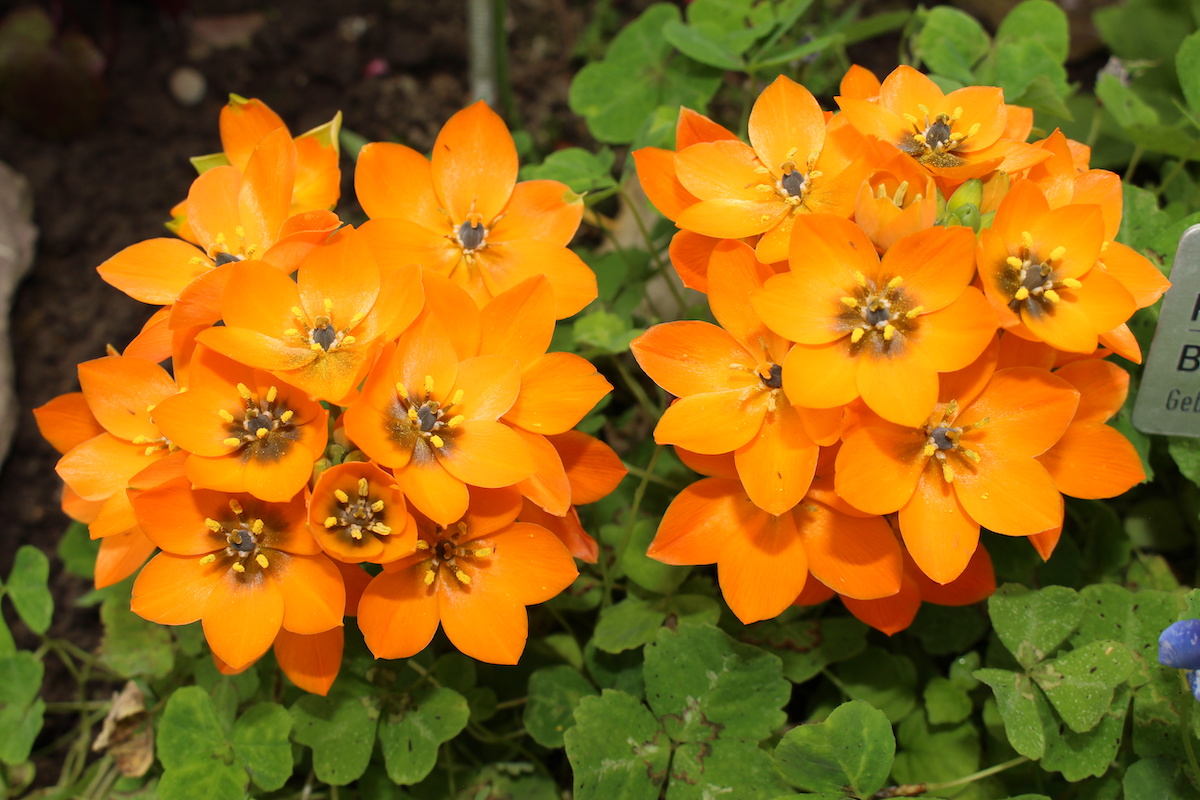
The main attraction of the orange star plant lies in its beautiful orange blooms, which form clusters. Each individual blossom is star-shaped, with six petals arranged in an open cup formation and measuring approximately 1 inch (2.5 cm) in diameter. At the center of the orange flower, you will find a brown or black component. These clusters can contain anywhere between five to twenty-five orange blooms, creating a delightful display of color.
Orange Star (Ornithogalum dubium) Care Guide
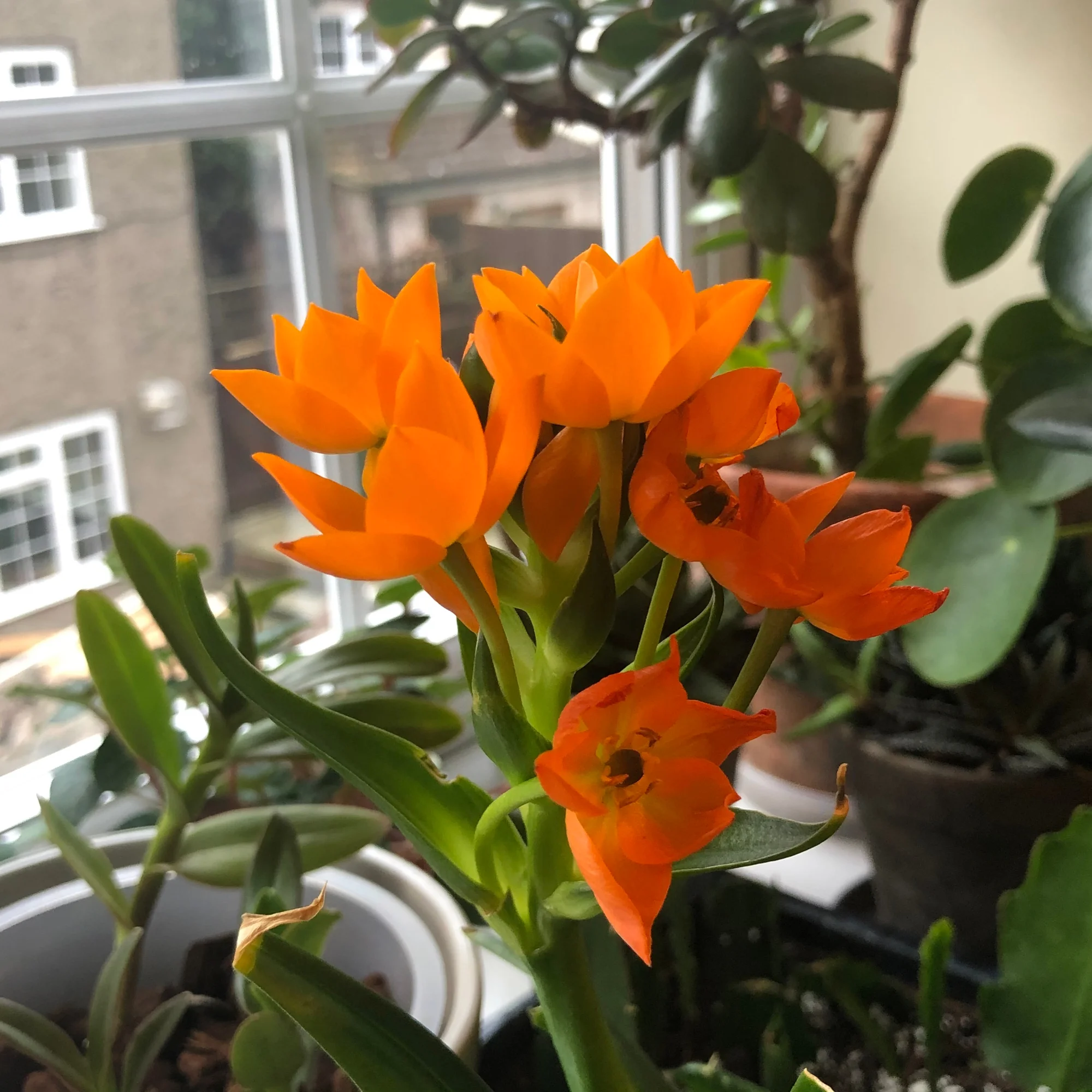
In this discussion, we will delve into the art of nurturing an orange star plant, ensuring its longevity and consistent blooming season after season.
Where to Grow Orange Star Plant
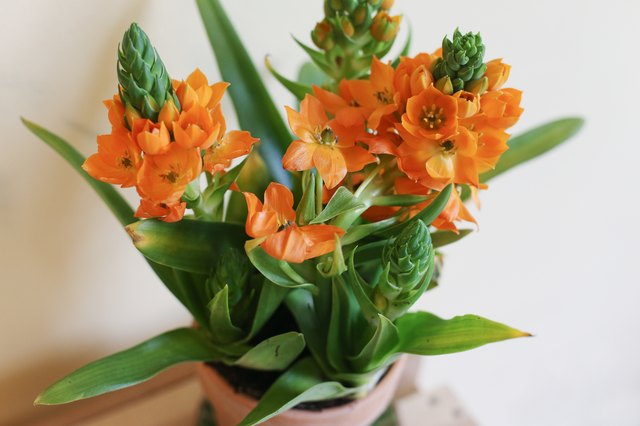
Choose the sunniest spot in your garden to plant the bulbs of the orange star plant, scientifically known as Ornithogalum dubium. Opt for an area with sandy or loamy soil that offers good drainage, as this will provide an ideal growing environment for the bulbs. Consider planting the orange star bulbs in a rock garden or a raised bed within your yard for optimal results.
Orange Star Plant Light Requirements

Orange star plants require full sun, meaning they need a minimum of six hours of direct sunlight each day. Growing them in abundant sunlight ensures more flowers and a longer blooming period. However, it’s important to provide some afternoon shade during extremely hot and sunny days to prevent damage. These plants struggle to thrive in shaded areas.
Therefore, avoid planting orange star flower bulbs under trees or in flower beds that are consistently shaded. Insufficient sunlight results in fewer blooms and underdeveloped bulbs, as these plants do not perform well in damp and cold soil.
If your lovely orange star plant exhibits slow growth, poor blooming, yellowing leaves, or quickly wilting flowers, it is a clear indication that it needs more light. Consider moving the plant to a brighter location to promote healthier growth. When growing orange star plants indoors, the ideal spot is a warm area that receives at least six hours of indirect light and some direct light.
For the best blooms, place potted orange star plants in an east-facing window, where they receive gentle morning sunlight. If placing them in a south-facing or west-facing window, make sure to provide some protection from the intense afternoon sun.
Orange Star Plant Soil Requirements
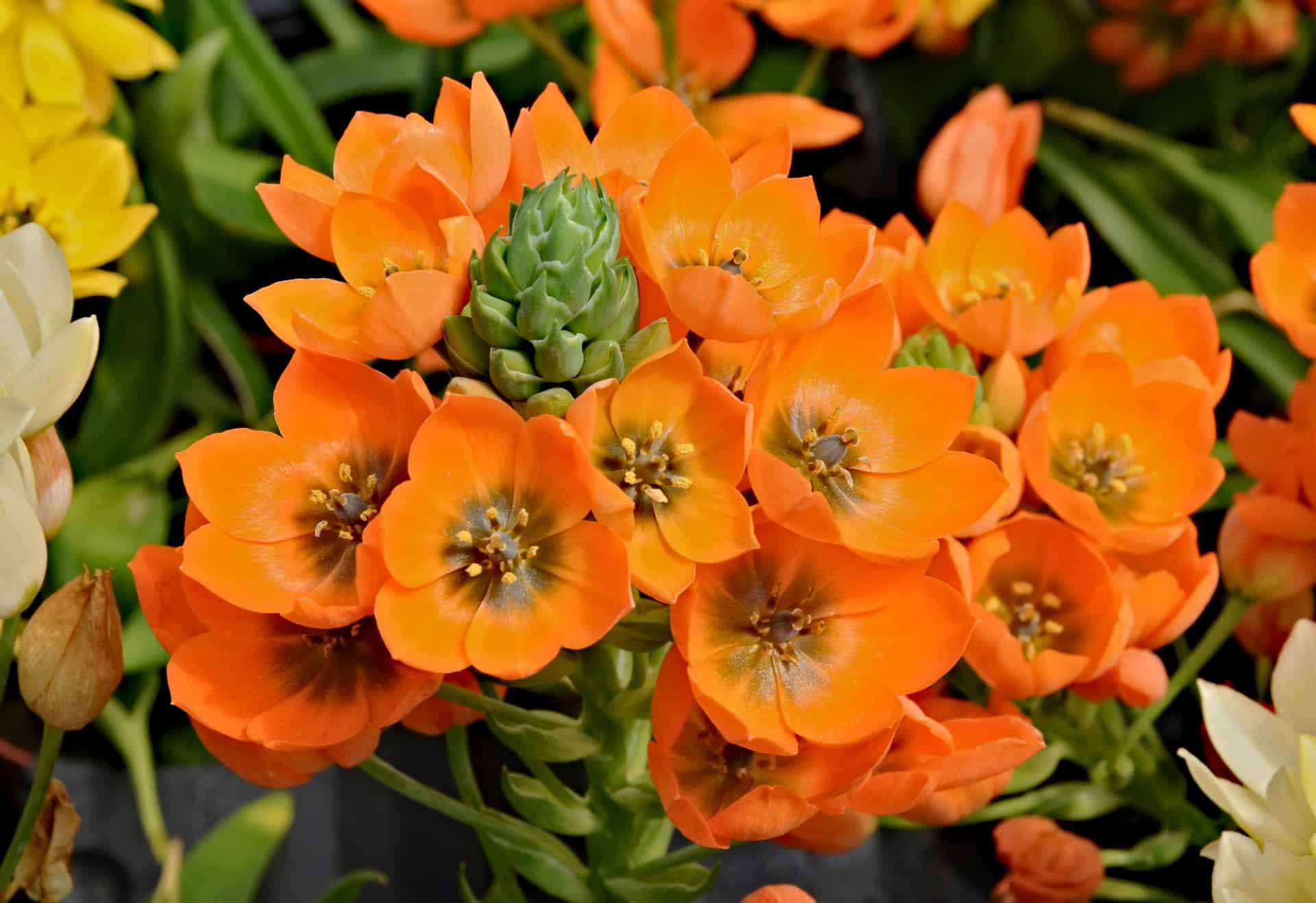
Orange star flowers flourish best in well-drained, nutrient-rich loamy soil. It is crucial to avoid soil that becomes overly soggy or waterlogged, as this can lead to bulb rot. When planting orange star bulbs in a garden setting, ensure that the soil has proper drainage. In colder regions, it is advisable to dig up the bulbs in autumn to prevent damage caused by cold and waterlogged soil during winter. The article will provide further details on how to successfully overwinter Ornithogalum dubium bulbs.
When cultivating potted orange star plants, it is essential to use a fertile potting mix that incorporates sphagnum peat moss and perlite. A recommended potting soil mixture consists of three parts regular houseplant soil, one part peat moss, and one part perlite. The peat moss aids in moisture retention, while the perlite promotes proper drainage, ensuring a healthy growing environment for the potted orange star plants.
How to Water Orange Star Plant
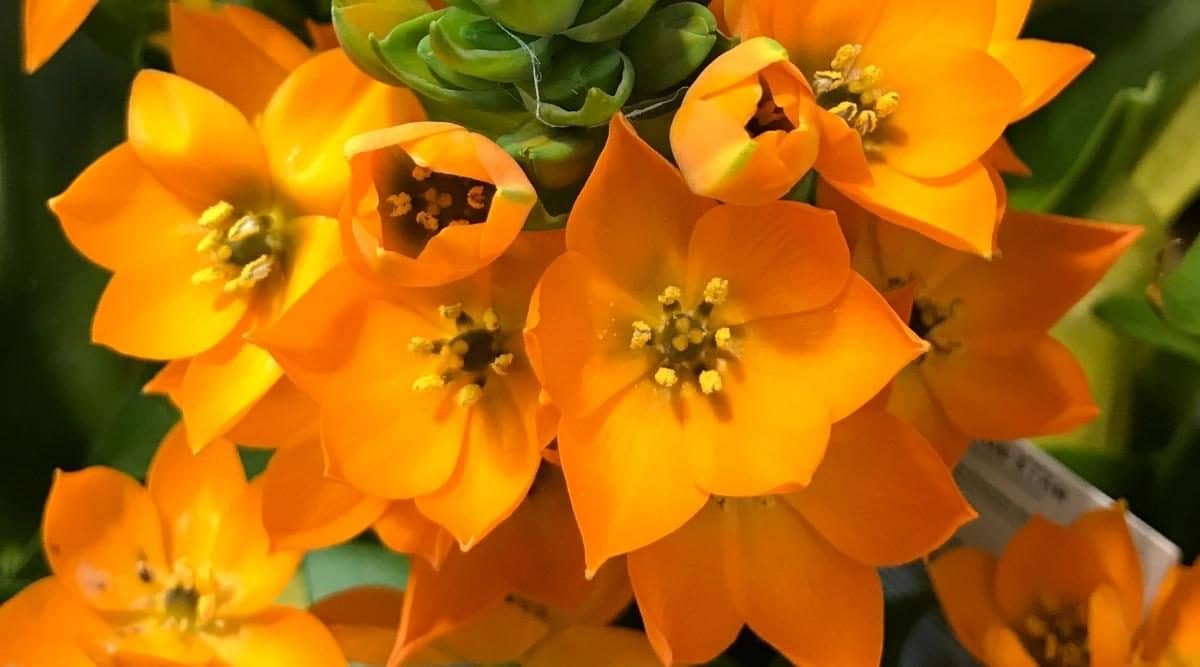
For both outdoor and indoor orange star plants, it is recommended to water them when the top few inches of soil have dried out. When watering the ground beneath the plant, ensure thorough watering to promote bulb development. The goal is to maintain moisture in the soil without making it overly soggy, so watering when the top 2 inches (5 cm) of soil is dry is a good practice.
During the spring and summer seasons, weekly watering is typically sufficient for an orange star plant. However, if the weather is particularly hot, you may need to water the plant twice a week. If you choose to leave the bulbs in the ground over winter, water just enough to keep the soil moist.
When it comes to potted orange star plants, they thrive when the soil is kept adequately moist. Water the potting soil only when the top layer feels dry, similar to the approach for outdoor plants. Fill the pot with water until it fills the drainage holes at the bottom, allowing the excess water to drain. Then, place the pot in a warm and brightly lit location to support ongoing growth. Establishing a proper watering schedule is crucial for successfully caring for an orange star plant.
Signs of underwatering the Ornithogalum plant include falling flowers, slow development, and yellowing leaves. It’s important to note that orange stars are not tolerant of drought conditions. On the other hand, overwatering can lead to mushy black stems, excessive growth, and ultimately, plant death. During the winter months, potted indoor orange star plants typically do not require watering.
Temperature Requirements for Orange Star Flower

Orange star plants thrive within a temperature range of 60°F to 80°F (16°C to 27°C). In colder regions, these plants are not cold-hardy and cannot survive in outdoor soil. Therefore, cultivating them indoors is recommended, maintaining average room temperatures. The optimal USDA hardiness zones for orange star plants are 7 to 11. In hotter climates, providing some protection from the intense afternoon sun is beneficial for the plants.
For regions in zones 6 and below, orange star plants can be overwintered indoors in a cool and dry location. Alternatively, you can bring these heat-loving plants indoors from fall to early spring and keep them in containers. Sudden temperature fluctuations can be detrimental to orange star plants, so it is important to shield container plants from air conditioning drafts, chilly window breezes, and hot radiators if they are kept indoors.
Humidity Requirements for Orange Star Plant
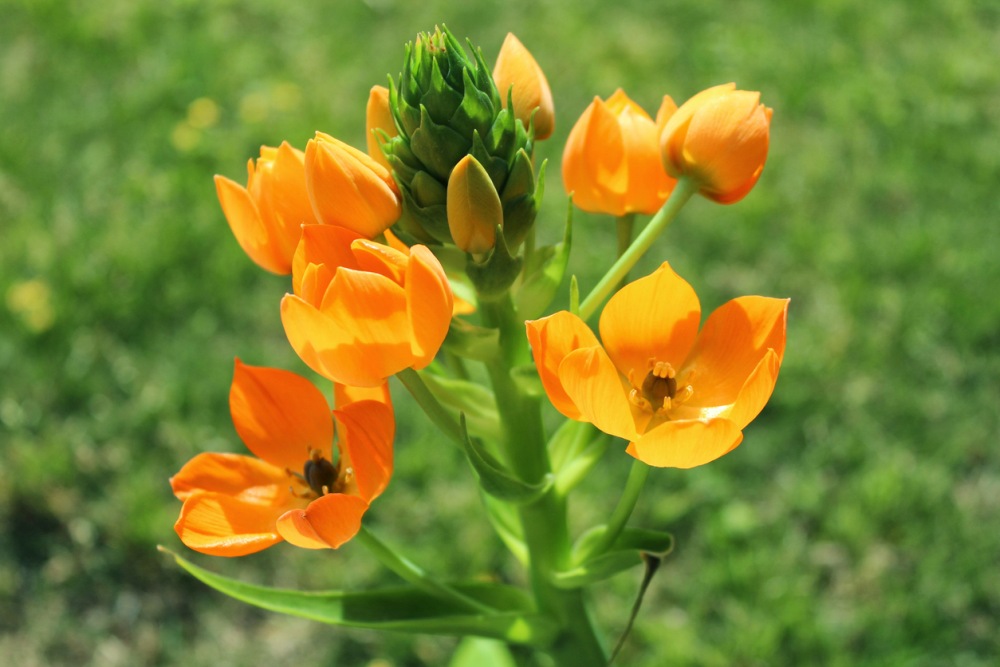
Orange star plants thrive in outdoor environments with low humidity. As long as the plant receives sufficient sunlight and is planted in well-drained sandy soil, there should be minimal growing issues. It is important to ensure adequate air circulation around the foliage.
Potted indoor orange star plants, on the other hand, require only average room humidity to flourish. Excessive humidity and insufficient air circulation can lead to fungal problems such as powdery mildew. Therefore, there is no need to mist the leaves of the plant. Additionally, avoiding leaf spot issues is another reason why misting the leaves is unnecessary.
Fertilizing Orange Star

For abundant orange flowers, regular fertilization is key when it comes to the orange star plant. Using a high-potassium fertilizer can effectively enhance flower growth. Fertilizers play a vital role in replenishing the necessary nutrients in the soil that are essential for the health and development of ornamental plants.
There is a wide range of organic fertilizers available that are suitable for flowering garden plants. However, it is crucial to carefully follow the guidelines provided by the manufacturer regarding the appropriate amount of fertilizer to be used. Additionally, incorporating organic compost into the soil during springtime can provide an extra boost to the growth of orange star plants.
When it comes to potted orange star plants, it is advisable to administer a diluted all-purpose houseplant feed once a month. This will support the growth of the orange blooms throughout the spring and summer seasons. However, it is important to refrain from watering and fertilizing during the winter months.
Pruning Orange Star Plants
Only yellowing or dead leaves should be removed from an orange star plant. To help the plant appear better and concentrate growth in healthy foliage, you may cut the leaves to the ground. The leaves of the orange star plant will fall off after it blooms and go dormant.
Orange Star Plant Propagation

One of the effective methods for growing an orange star plant is by separating offsets from the bulbs during autumn. Dig up the bulbs and detach any small bulbs attached to the main plant. Then, use a sharp and sterile knife to separate the bulbs, which can be planted in pots or in the ground. It is recommended to divide the bulbs every five or six years. During winter, propagate orange star bulbs in pots by placing them in a cool location with moist soil. New growth should emerge in spring.
Another approach to cultivating a new Ornithogalum dubium plant is by collecting seeds after the blooming period. Towards the end of summer, the seed pods will turn brown. Allow the seed pods to dry for about a week before removing them from the plant. Carefully extract the seeds from the pods and store them in a cool and dry place.
To plant the seeds, use a light and moist potting mix composed of peat moss, fine bark, and perlite. Sow the seeds in autumn or spring, covering them lightly with soil. Keep the seeds in a shady location until they germinate. It may take up to four years for an orange star plant to bloom from seeds.
Repotting Orange Star Plants
Towards the end of summer, it’s beneficial to repot orange star plants. Repotting them in larger pots allows the bulbs to have more space for growth. This is also a good opportunity to check the health of the bulbs, refresh the potting soil, and propagate offsets if desired. To repot the orange star plant, carefully remove the bulb from its current pot. Place the bulb at the same depth as before in a new pot filled with suitable potting soil. Once repotted, ensure the plant is placed in a sunny area and watered thoroughly.
Sun Star Plant Winter Care
In colder regions, it is important to protect Ornithogalum bulbs from frost during winter. Before the first frost date, remove the bulbs from the ground and clean off any foliage. Allow the bulbs to dry in a cool and dark area. Once the danger of frost has passed, the bulbs can be replanted in the ground during the following spring. If you choose to leave the bulbs in the garden during mild winters, providing a thick layer of mulch can help protect them from the elements.
Pests Affecting Orange Star Plant Growth
Orange star plants are generally resistant to common houseplant pests. However, one pest that can affect their growth is thrips, which can occur both indoors and outdoors. To remove thrips from garden plants, you can use a strong stream of water from a hose to wash them off.
If you notice thrips on your orange star plant, it is advisable to isolate it from other houseplants. Spray the plant with neem oil once a week to disrupt the thrips’ lifecycle. Continue using natural pesticide sprays regularly until all signs of pests are eliminated.
Diseases Affecting Orange Star Plant Growth
The most common disease issue for orange star plants is root rot. Overwatering can lead to rotting bulbs and potential plant death. Similarly, storing bulbs in damp conditions during winter can also cause rot. To prevent root rot, ensure thorough watering by allowing the soil or potting mix to dry out between waterings. Water the plant generously when the soil has mostly dried, and refrain from watering again until the soil has dried out.
Orange Star Plant Care – FAQs
Is the orange star plant toxic?
All parts of the orange star plant (Ornithogalum dubium) are toxic if ingested. It is important to prevent dogs, cats, and humans from consuming the leaves, roots, or flowers of the plant.
Why are my orange star plant leaves turning yellow?
Yellowing of orange star plant leaves can be due to insufficient sunlight, poor soil conditions, or excessive watering. Providing bright light and watering only when the soil is dry can help restore the plant’s health.
Do Sun Star plants come back every year?
If the bulbs survive the winter, orange star plants will come back year after year. In sandy soil and in zones 7 and above, consistent blooming can be ensured. For colder areas, bringing the orange star bulbs indoors during winter is recommended to protect them from fr
